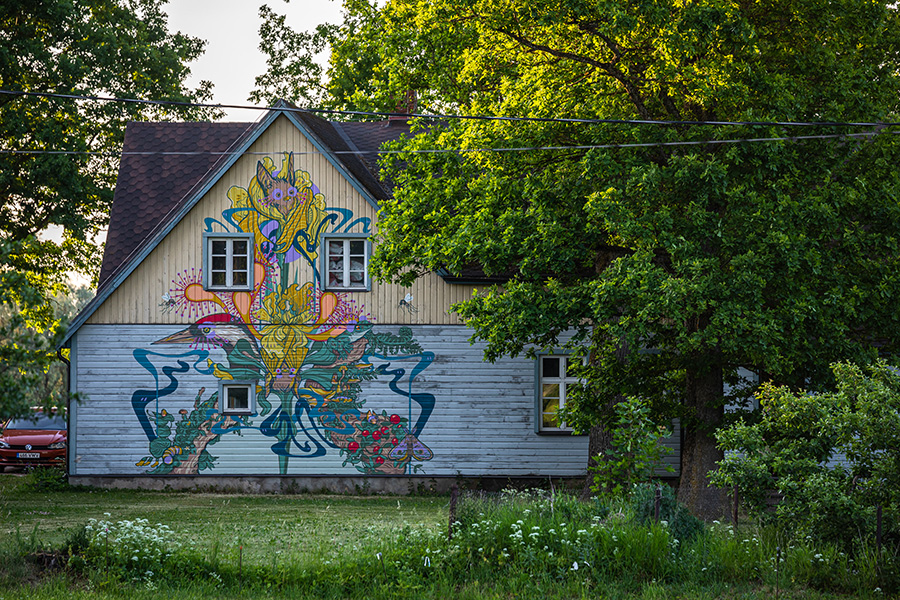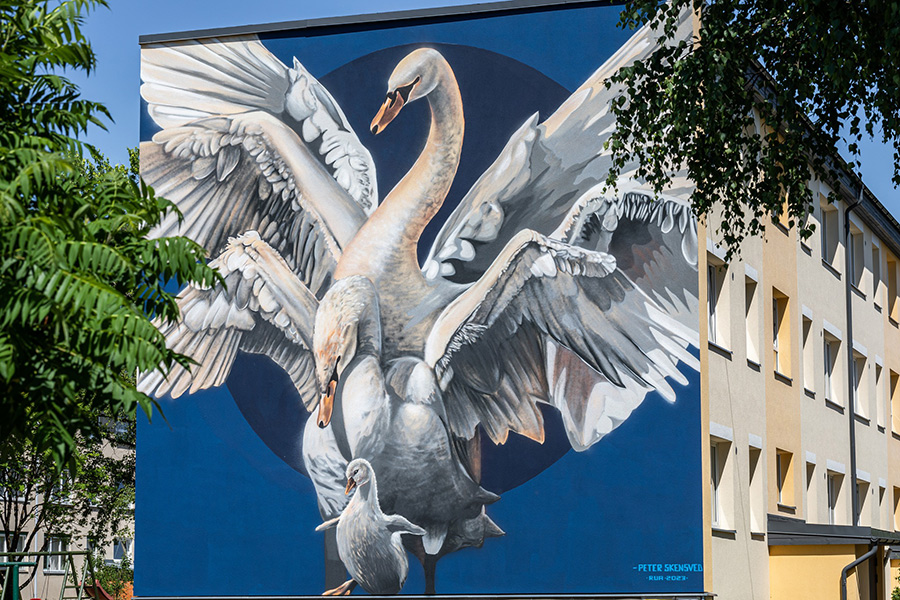In the quiet embrace of rural Estonia, street artists find a harmonious refuge.
With the century’s turbulent past, its break with Moscow in the 90s and its joining with NATO and the EU in the 2000s, Estonia today enjoys political stability, economic growth, a thriving tech sector, and a progressive social welfare that enhances the well-being of the average Mari and Jaan. As with most European and American cities, there is an established or burgeoning street art and graffiti scene, with a healthy representation of the styles and techniques interpolated through a local lens, and the reverberations of pop satire, Bansky humor, and certain anarchic stencibilites on streets. Since 2018, the mural aspect of the street art movement has traveled to rural areas as well via the Rural Urban Art (RUA) Festival in small villages to bring people out of their homes to engage in a public art that is new and unusual to many.

This June, artists from Estonia and eight other countries spread out across small villages of Viljandi municipality whose populations range from a couple of hundred to a couple of thousand to introduce aesthetics and sensibilities emanating from more heavily populated areas, now firmly in new contexts. “Many local people saw such action for the first time and all the while, the feedback and emotions were so highly positive,” says Salme Kulmar, the creator of the festival, “It’s a sign that visual art also belongs to small towns and that there is actually a need for it!”

Like the Fanzara Miau Mural Festival in Spain and the Utsira project on an island of 200 inhabitants in Norway, the efforts of RUA organizers are focused on smaller audiences than a typical festival, yet the impact of art on the streets can be as profound as the splashy commercial ones in London, Montreal, or Brooklyn. Each edition of the festival has been staged in different areas, earning RUA the distinction of calling itself a nomadic street art festival. The scale can be small or larger, like the 86 meter mural by Ukrainian artist Andrey Kovtun this year.

There’s something about the feedback here that seems to resonate on a deeper, individual level.
“Throughout the festival we felt a lot of love from the locals,” says Kulmar of the various artists interactions with neighbors and families. Among the accounts, residents of one building cooked lunch for the Italian artist daily while he worked, some locals in Päri village hosted a celebration for Ukrainian artist Andrey Kovtun, and a final celebration including a smoke sauna invited all the artists to the home of Ulvi Tatar in Kolga-Jaani village.
“It was a week full of love,” says Kulmar. And murals of course.

Artists of RUA 2023 included: Andrey Kovtun, Luogo Comune from Italy, Peter Skensved (Denmark), Myforestbridge from Ukraine, Maxime Ivanez and Annabelle Tatto from France, Pidžin from Lithuania, Maikki Rantala from Finland, Uneg from Mexico, Karolis Dezute from Lithuania, Andrey Kovtun (Ukraine).




















Other Articles You May Like from BSA:
Wishing you a safe and fun 4th of July celebration. In these tumultuous days, it is good to remember that the Boston Tea Party was the people's rebellion against an unholy alliance of government and...
Shopping at an art fair this week? Why not buy something that directly benefits the culture that street art and graffiti came from? In Mongolia. Martha Cooper in collaboration with Learn &...
Aerosol in pursuit of the “Masters” (Eurocentrically speaking) is a permutation of Street Art and the mural making tradition going back decades, including murals made directly by “Masters” (Latino-ce...
Clandestine abandoned former factories are ideal locations for graffiti writers to practice their skills. Regardless of your intuition or expectations, you never know what you'll find. Graffiti piece...
Love seeing people like this high school gent on the train and in the street and on the elevator and in the store - in gentle anticipation of giving a rose to the one he has a crush on. Sending love ...
 BROOKLYN STREET ART LOVES YOU MORE EVERY DAY
BROOKLYN STREET ART LOVES YOU MORE EVERY DAY










